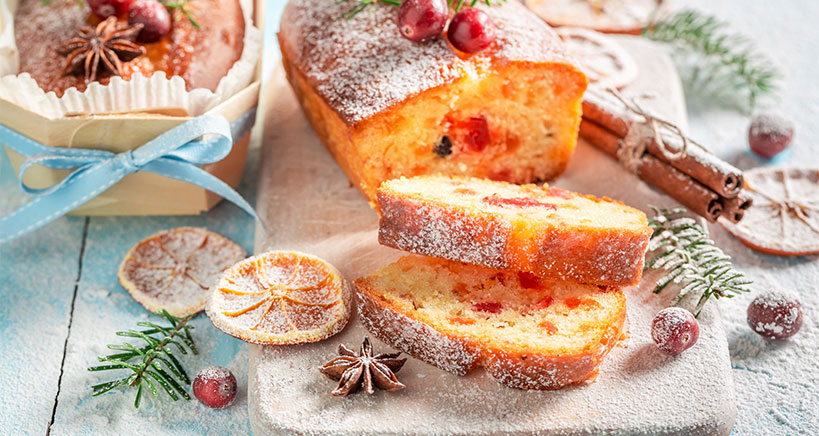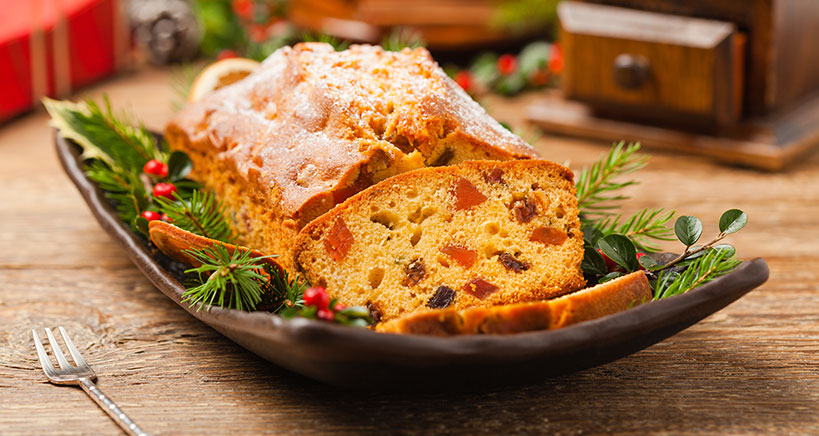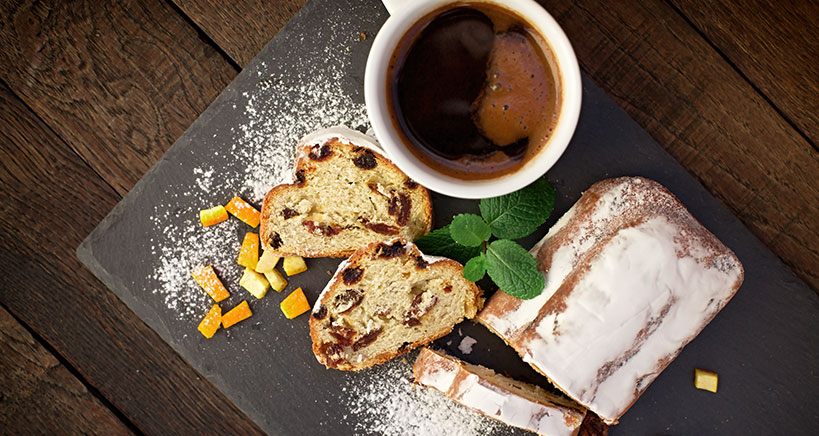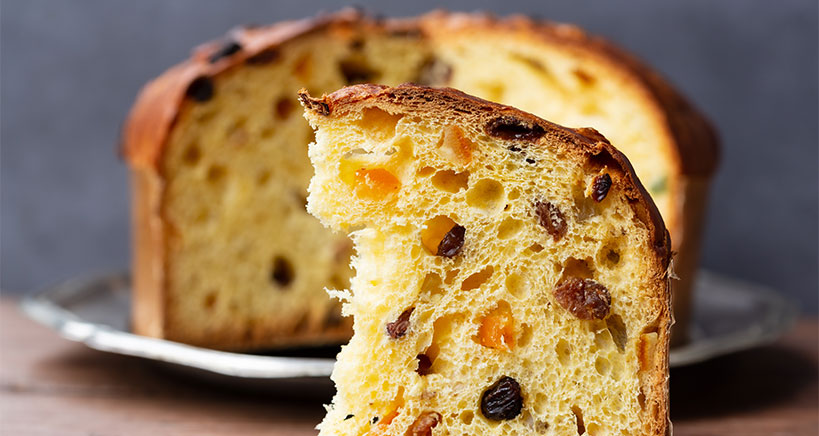
Fruitcake season is here, and with it, a golden opportunity for your restaurant to feature far out fruitcakes and attract the masses of holiday consumers to your eatery. While no one knows exactly how the dense, candied, nutty, sweet, and booze-soaked dessert became associated with the Christmas tradition, the fact is that customers wait all year long to indulge in the traditional treat. At the same time, they are ready and eager to sink their teeth into new and updated recipe.
From Fruitcake Classics to Flavorful Twists
Typically eaten by the slice and popularly given away as holiday gifts, new flavorful twists on the age-old dessert include recipes for fruitcake cookies, bars, mini-bites, shortbread, and even fruitcake waffles and donuts! Decadent no matter how they are prepared, let’s learn more about the culinary science and art of making magnificent fruitcakes. To do so, take off your apron, take a load off your feet, and prepare to take a journey into the past as we indulge in some fascinating fruitcake history…
History of Fruitcakes Across the Ages
Did you know that the modern-day fruitcake has been making the global rounds for millennium? Food historians have determined that the placing of cake loaves on the tombs of loved ones was customary as far back as ancient Egypt, over 3,000 years ago (perhaps as nourishment for the afterlife). But it was not until ancient Roman times that the fruitcake became popular and really took off. Touted for its portability and long shelf life – and hence frequently brought to the battlefields by Roman soldiers – the first fruitcakes were made of a pomegranate-pine nut-barley mash that was molded into a ring-shaped dessert.
Similarly, during the Middle Ages, fruited breads were widespread among Crusaders travelling the world and featured the addition of preserved fruits, spices, and honey.
As the sweet cakes and breads made their way into Western European cuisine in the 16th century, ingredient variations began to appear. First, the addition of cheap, easily obtainable sugar became common, adding to the recipes’ density. Also on the menu were cakes filled with nuts, dry fruits, and eventually the introduction of alcohol during the Victorian era.
By the 18th and 19th centuries, with each successive year adding another taste or texture, fruitcakes not only became synonymous with decadence, but they were even outlawed in some parts of Europe where they were deemed “sinfully rich.” The law was soon repealed due to fruitcake’s prominence at ‘tea time,’ especially in England, however the Smithsonian Magazine tells us that fruitcakes became a rare delicacy reserved for special occasions such as weddings and holidays. Continuing to be associated with decadence and indulgence today, fruitcakes have maintained their aura of specialness, making them that cherished holiday treat we see in such high demand today.

Fruitcakes from Around the World
Following fruitcake’s trajectory around the world, Italian cuisine features a sweet-and-spicy “panforte” or “strong bread” also known as “pannetonne.” Germany’s famous “stollen” – a tapered bread-like loaf coated with melted butter and sprinkled with powdered sugar – has been a national treasure since the late 1400s and has even earned its own annual festival. The Caribbean Islands introduced a boozy “black cake”, while Britain’s fruitcake varieties have been likened to its plum pudding tradition, where the fruit is soaked in rum for up to one year. Bulgarian and Polish versions are called “keks,” and Portugal boasts the “bobo rei” with a hidden fava bean inside (the lucky/unlucky finder of which is supposed to buy the next cake…). In Vietnam, the “banh bo mut” fruitcake is customarily made to celebrate the Lunar New Year.
Fruitcake Popularity
How popular is the holiday treat in the 21st century? In addition to the scores of store-bought fruitcakes that are mass-produced and the proliferation of homemade fruitcake recipes giving testament to their cherished status, evidence of fruitcake’s popularity could not be more blatant than the real-time example of the Collin Street Bakery in Corsicana, Texas. Specializing in the business of making fruitcakes since 1896 and famous for their sophisticated mail-order system, the bakery sells approximately 1.5 million cakes annually, with an estimated 30,000 a day at this time of year. As the familiar adage goes: The proof is in the pudding (or in this case, in the fruitcake!)
Types of Fruitcakes
In general, all fruitcakes are concocted from any, or all, of the following ingredients: Dried fruit, fruit rind, candied fruit, nuts, spices, and optional liquor or brandy. Some cakes are steeped in rum, for example, while others are booze-free.
Fruitcakes can be classified into two types:
- Light Fruitcake, as its name indicates, is made from light-colored ingredients such as light corn syrup, white sugar, golden raisins, apricots, pineapples, and almonds.
- Dark Fruitcake is made from darker ingredients such as brown sugar, molasses, prunes, dates, raisins, pecans, walnuts, and cherries.
In all its formulations, the proportion of fruit and nuts relative to the batter is high, with just enough cake batter to hold the mixture together. This results in a very heavy, dense, and moist cake that is known for tasting better over time. In fact, the recommendation to “age” a fruitcake is one of its most outstanding properties.

Aging a Fruitcake
Fruitcakes that are left to age (for days, months, or even years) develop rich and complex palate-pleasing flavors. While this phenomenon is correctly attributed to the alcohol content which serves as a food preservative, there are additional little-known factors contributing to the longevity. Namely, dried and candied fruit that have a ‘low-water activity’ property which prevents moisture-loving bacteria from reproducing. As a result, baked goods that are packed with dried fruits can keep for weeks without going bad, maintaining a stable shelf life if wrapped properly.
To age their cakes, some bakers start soaking the recipe ingredients (typically in rum) months in advance, while other recipes call for a full month of ripening once the cake is already baked. Either way, ideally, fruitcake experts recommend reserving at least a few days for prep time, allowing you to soak the chopped nuts and fruits in liquor and/or fruit juice, cover, and leave standing for 2-3 days prior to making the batter and baking.
Fruitcake Making Tips and Tricks
The holiday baking season is here and to help you and your restaurant business achieve fruitcake success, follow these expert guidelines.
- For customers on diets that preclude consuming sugar, candied fruit or peels, simply add more dried fruit varieties – think mango, papaya, bananas, peaches, apricots, currants… and more.
- To save on costs and make your own candied fruit, dip or boil orange rind, lemon rind, cherries, or pineapple chunks in heavy syrup and leave to dry. Once dried, roll in granulated sugar.
- To bake, preheat your oven for one hour. Expect baking time to last between 80 to 90 minutes.
- Since the cakes are laden with fruits that release juices during the baking process, fruitcakes need to be baked slowly at a low temperature of 275-325 degrees F or 135-165 degrees C.
- With so many different types of fruitcake ingredients, color is insufficient as an indicator that the cake is done. Instead, check for readiness by poking a toothpick or knife near the cake’s center and verify that it comes out clean.
- The longer your fruitcake timeline, the moister and more flavorful they will be! To ensure that your aging fruitcake does not dry out, unwrap once a week and brush with rum, brandy, or any sugary syrup. Rewrap tightly.

How to Store and Freeze a Fruitcake
- To keep a liquor-based fruitcake for months or even years, wrap in foil or a cloth and store in a cool place. To preserve cakes made without alcohol, store in the refrigerator for the short term or in the freezer for longer.
- The most common technique for storing fruitcakes is wrapping them in a liquor or liquid-dampened cheesecloth and storing in the fridge or in an airtight container in a cool, dark place.
- A less common but classic method of aging a fruitcake is to coat the cake in a thin layer of marzipan, followed by a coating of icing. The icing creates a protective seal that keeps the cake moist.
- While freezing fruitcakes is highly recommended, be sure to age them prior to freezing, allowing the ingredients to ripen, mellow, and blend.
New in Fruitcakes
If you are looking for tasty and innovative ways to update your fruitcake menu, you and your customers are in for a treat! Just in time for the holidays, here are some of the latest fruitcake variations making their way across the nation…
Featured by renowned executive chef Josh Capon, three new holiday desserts shaking up the traditional menu are: Fruitcake French Toast topped with melt-in-your-mouth eggnog whipped cream; Fruitcake Waffles topped with vanilla ice cream and a cherry on top; Fruitcake Donuts topped with a delectable and sweet sprinkling of powdered sugar.
Also transforming holiday dessert trays are creations such as Pumpkin-Spiced Fruitcake Pinwheels, Assorted Mini-Fruitcakes, Fruitcake Shortbread Cookies, Golden Apricot Jam Fruitcakes, Chocolate Cherry-Berry Fruitcakes, and even Last-Minute Fruitcakes which can be prepared in as little as 45 minutes…
In Sweet Summary
For many customers, it’s not Christmas without fruitcake. Fortunately, now that you have learned the secrets for fruitcake success, your restaurant, catering business, or other eatery is set to kick off the holiday baking season on the right foot. Good luck on your culinary endeavors and Happy Holidays!